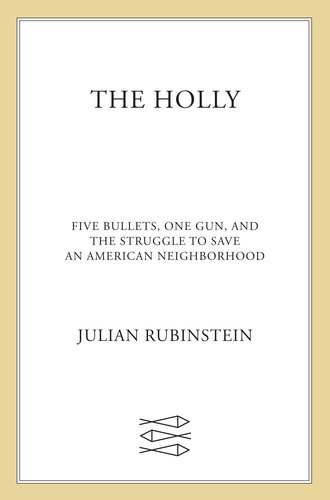
The Holly
Five Bullets, One Gun, and the Struggle to Save an American Neighborhood
- اطلاعات
- نقد و بررسی
- دیدگاه کاربران
نقد و بررسی

March 1, 2021
Rubinstein, whose work has appeared in the New Yorker, Rolling Stone, and the New York Times Magazine, and whose Ballad of the Whiskey Robber (2004) was a finalist for the Edgar Award in Best Fact Crime, has constructed a shattering piece of investigative journalism involving street gangs, race relations, and law enforcement. Rubinstein's focus is on three acres outside of downtown Denver called the Holly, a traditionally Black area that once housed a shopping mall, then morphed into Crips and Bloods gang territory, and was about to be redeveloped as a community hub in 2013. The pivotal moment for Rubinstein's investigation came on 9/20/2013, when Terrance Roberts, a former Blood, ex-con, and anti-gang violence activist, shot a gang member at the peace march Roberts himself had organized. Rubinstein spent seven years uncovering what actually happened that day, using court records, police reports, interviews with community leaders, and numerous interviews Roberts conducted himself. This is a gripping deep dive into media underreporting and too-quick judgment, and, most shockingly, into how the criminal-justice industrial complex may be invested in systemic corruption designed to keep drug wars going. Dramatic and wrenching.
COPYRIGHT(2021) Booklist, ALL RIGHTS RESERVED.

April 1, 2021
In 2013, activist Terrance Roberts shot Hasan Jones, who was allegedly a gang member, during a rally in a Denver neighborhood known as the Holly. Rubenstein (Ballad of the Whiskey Robber) looks at history, activism, and politics in Denver to better understand the forces that contributed to the shooting. The Holly is a historically Black neighborhood in Denver; it was a pivotal center of the community when Roberts's grandmother moved there during the 1950s. After the U.S. government dismantled civil rights protections, residents of the Holly experienced increased gang violence, and the area was left to decay by the predominantly white local government. Roberts joined a gang to defend his community, but after several terms in prison he became a community activist dedicated to stopping gang violence in his neighborhood. Despite his efforts, the influence of local politicians and interests limited his success. Rubenstein explores many aspects of the war on drugs, including policing, gang violence, activism, and the role of local and national politics. VERDICT An informed analysis of the complex intersections between police and the community, which will especially draw in readers involved in community organizing and anti-racist activism.--Rebekah Kati, Univ. of North Carolina, Chapel Hill
Copyright 2021 Library Journal, LLC Used with permission.

March 15, 2021
Journalist Rubinstein tells the haunting story of a former gang member who tried to go straight and ran into a skein of political, philanthropic, and law enforcement interests. When Ernestine Boyd, a grandchild of slaves, fled to Denver from the Jim Crow South, she became one of the first Black residents of the Northeast Park Hill part of the city, which included the Holly, a neighborhood that would earn a reputation as "the proud center of the city's civil rights movement." Decades later, Boyd's grandson Terrance Roberts left his own mark on the Holly. He had found God and quit the Bloods while in prison; after his release, he founded an anti-gang nonprofit that led the mayor to name him "one of Denver's 150 Unsung Heroes." Roberts' standing in the city began to unravel when, at a rally marking the opening of a Boys & Girls Club in the Holly, he shot a member of the Bloods who had credibly threatened him. In a multigenerational saga that builds toward a suspenseful courtroom drama centered on Roberts' trial for assault and attempted murder, Rubinstein--who grew up and still resides in Denver--creates a historical palimpsest that sets its events against the backdrop of broad social and political changes, including the Crips' and Bloods' spread from Los Angeles to Denver; the Clinton administration's decision to treat street gangs as "organized crime" groups; and the often clashing aims of politicians, philanthropists, and Black leaders. The author offers especially sharp and well-developed scrutiny of the use of active gang members as confidential police informants, but this important book is about more than dubious policing. A larger theme is how difficult it is for gang members to go straight while their former partners in crime still have the power to harm them, the problem a Denver activist chillingly summed up in a Chinese proverb: "He who mounts the tiger can never get off." A true-crime tale vividly portrays a Denver hidden by picturesque vistas of its snow-capped mountains.
COPYRIGHT(2021) Kirkus Reviews, ALL RIGHTS RESERVED.




دیدگاه کاربران